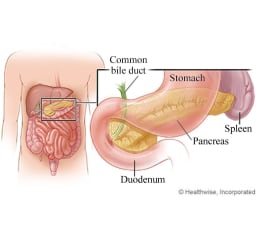Overview

The pancreas is an organ behind the stomach that makes hormones and enzymes to help your body digest food. Sometimes the enzymes attack another part of the pancreas, which can cause pain and swelling. This is called pancreatitis.
Chronic pancreatitis may cause you to be in pain much of the time. You may be able to help the pain by avoiding alcohol and eating a low-fat diet.
Your doctor and dietitian can help you make an eating plan that does not irritate your digestive system. Always talk with your doctor or dietitian before you make changes in your diet.
Follow-up care is a key part of your treatment and safety. Be sure to make and go to all appointments, and contact your doctor if you are having problems. It's also a good idea to know your test results and keep a list of the medicines you take.
How can you care for yourself at home?
- Do not drink alcohol. It may make your pain worse and cause other problems. Tell your doctor if you need help to quit. Counseling, support groups, and sometimes medicines can help you stay sober.
- Ask your doctor if you need to take pancreatic enzyme pills to help your body digest fat and protein.
- Drink plenty of fluids. If you have kidney, heart, or liver disease and have to limit fluids, talk with your doctor before you increase the amount of fluids you drink.
- If you get full quickly or have a hard time eating enough, try to eat smaller amounts more often throughout the day.
If your doctor has recommended a low-fat diet:
- Choose lean protein foods. These include poultry such as chicken and turkey without skin, lean meat, fish, egg whites, tofu, and beans.
- Cut off all fat you can see.
- Avoid fish canned in oil, such as tuna or sardines in oil.
- Bake, broil, or grill meats, poultry, or fish instead of frying them.
- Choose nonfat or low-fat versions of dairy products like milk, yogurt, and cheese.
- Try fat-free sour cream, cream cheese, cottage cheese, or yogurt.
- Avoid cream soups and pasta in cream sauces.
- Choose low-fat ice cream, frozen yogurt, or sorbet. Avoid regular ice cream.
- Pick bread, crackers, rice, and pasta that are made with little or no fat.
- Avoid high-fat foods such as croissants, scones, biscuits, waffles, doughnuts, muffins, granola, and high-fat breads.
- Flavor your foods with herbs and spices (such as basil, tarragon, or mint), fat-free sauces, or lemon juice instead of butter.
- Try applesauce, prune puree, or mashed bananas to replace some or all of the fat when you bake.
- Limit fats and oils, such as butter, margarine, shortening, mayonnaise, and salad dressing. Use fat-free butter substitutes, fat-free mayonnaise, and fat-free dressing instead.
- Avoid high-fat foods, such as:
- Chocolate, whole milk, ice cream, processed cheese, and egg yolks.
- Fried or buttered foods.
- Sausage, salami, and bacon.
- Cinnamon rolls, cakes, pies, cookies, and other pastries.
- Prepared snack foods, such as potato chips and nut and granola bars.
- Coconut, avocados, and nuts.
- Learn how to read food labels for serving sizes and ingredients. Fast-food and convenience-food meals often have lots of fat.
Where can you learn more?
Go to http://www.healthwise.net/patientEd
Enter S950 in the search box to learn more about "Diet for Chronic Pancreatitis: Care Instructions".
Current as of: October 19, 2024
Author: Ignite Healthwise, LLC Staff
Clinical Review Board
All Ignite Healthwise, LLC education is reviewed by a team that includes physicians, nurses, advanced practitioners, registered dieticians, and other healthcare professionals.

